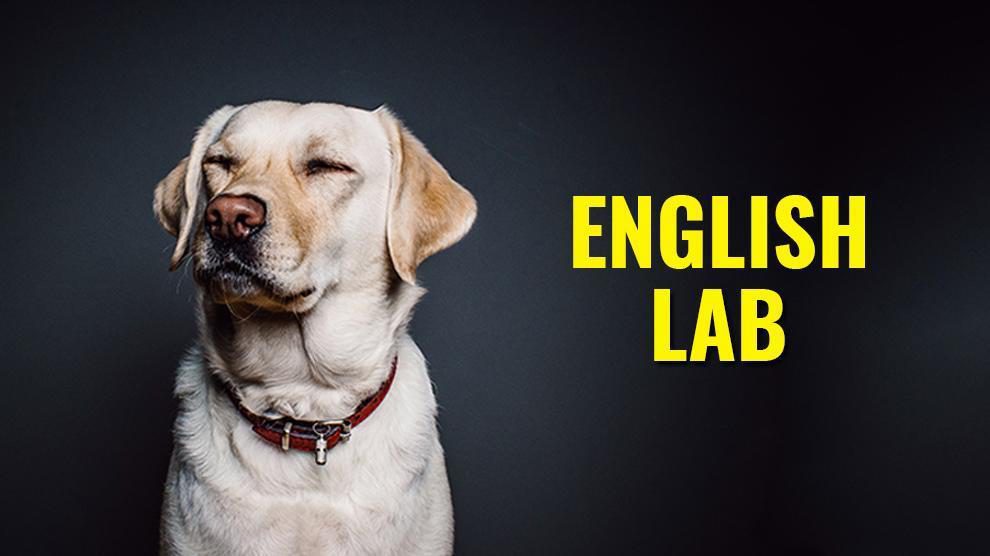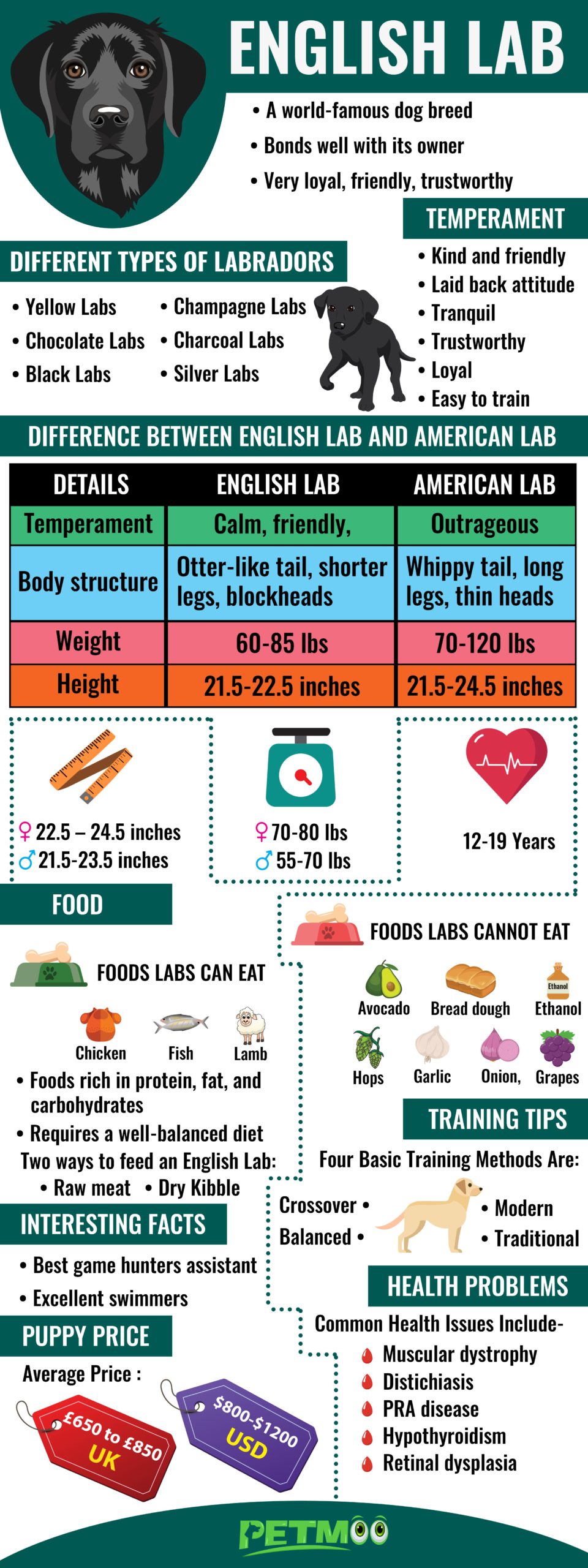- English Labrador Video And Infographics
- English Lab Breed Characteristics Sheet
- English Lab History And Appearance
- English Lab Facts
- English Lab Food
- English Lab Temperament
- English Lab Names
- English Lab Vs American Lab
- English Yellow Lab
- English Chocolate Lab
- American Labradors
- Labrador Training Tips
- Interesting Facts On English Labrador
- English Labrador Health Problems
- English Labrador Puppy Price
Dog Pregnancy Calculator And Timeline
The English Lab is a great dog breed that exists worldwide. The remarkable features of a Labrador dog are plenty.
It has good bonding with its owner and can fascinate many people. English labs have a habit of bringing things back and learning to retrieve things with ease.
They can swim very well due to the webbing that is present between the toes on their paws.
These dogs appear sturdy with a big head, broad chest, and shorter legs. In the UK, English Labs are used as a pet show dog and as a companion while going hunting.
There are different types based on coat colors.
- Silver labs
- Charcoal Labs
- Champagne Labs
- Black Labs
- Chocolate Labs
- Yellow Labs
First off, take this much-needed quiz and see whether you are up-to-date with all the facts. Besides, read the article to enrich your English Lab knowledge to keep your pet healthy and happy.
English Lab Breed Characteristics Sheet
- Origin: Newfoundland, Canada
- Size: Medium-large
- Dog Breed Group: Sporting group
- Purebred: Yes
- Lifespan: 10-12 years
- Height: Male – 22.5 -24.5 inches; Female – 21.5-23.5 inches
- Weight: Male – 70-80 lbs, Female – 60-70 lbs
- Coat Appearance: Double coat
- Coat Colors: Chocolate, black, yellow
- Temperament: Kind natured, well defined, smart
- Good With Children: Yes
- Intelligence Level: High
- Good With Pets: Yes under supervision
- Hypoallergenic: No
- Grooming: Moderate
- Shedding: High (seasonal)
- Barking: Barks when necessary
- Suitable For Apartments: Low
- Need For Exercise: High
- Easy To Train: Yes
- Good For First Time Owners: Yes
- Health Issues: Distichiasis, tricuspid valve dysplasia, muscular dystrophy, cataract
- Litter Size: 4-10 puppies
- Average Price: $800-$1200 (US)
English Lab History And Appearance
English Lab History
The Labrador retriever originates from Newfoundland, Canada. This breed was said to help the fisherman in the early days.
The British people were impressed with the dog’s ability to survive in a cold environment and brought a few dogs to their homeland.
Those dogs were then later developed and bred by them as English Labradors. This breed got its name as they are more common in the United Kingdom.
English Lab Appearance
The most beautiful breed, the English lab, is notable for its handsome, chisel-like head and thick, tapering tail. This dog has a large, massive head with large eyes that are well apart from the skull and pleases the owner with kindness.
Overall, it has a broad body and has a robust and well-proportioned neck, and a deep chest. You will fall in love with its classic, thick, heavy tail that will taper to a point and sweep downwards.
English Lab Facts
English Lab Size And Weight
A normal male stands 22.5 inches to 24.5 inches in height and weighs between 70 pounds to 80 pounds. A female dog’s height is 21.5 inches to 23.5 inches, and its weight is 55 pounds to 70 pounds.
The occurrence of canine obesity is prevalent in this breed. Care must be taken to ensure that the dog doesn’t put extra weight. English Labradors have a real penchant for food but it curtailing it is not an easy task.
The working dogs need more food during the winter than the summertime of a year.
Giving a fair amount of exercise to this dog will make it stay healthy and happy.
English Lab Life Span
The average lifespan of an English Labrador is 12 -13 years. Some Labradors have a life span of about 19 years.
English Lab Food
It is not that simple to decide the best dog food for an English Labrador puppy. Your English Labrador dog needs a well-balanced diet for overall development.
The two common methods to feed an English Labrador
- Homemade food and raw meat
- Dry kibble
Is kibble healthy for dogs?
Yes, but at the same time, dry kibble can produce allergies in Labs.
Advantages of dry kibble
Some of the important advantages of feeding dry kibble to your dog include
- Easy to store
- A quick way to feed your dog with enough nutrients
- Requires no refrigeration
- Makes dog treats even more interesting
Disadvantages of dry kibble
- Kibble fed dogs produce smellier and more quantity poop
- Labs fed exclusively on kibbles may require teeth cleaning every now and then
- Kibble fed Labs may eat their own poop
If Labrador displays average weight, good energy, healthy stools, and a shiny coat, it means the Labs are eating the right kind of food.
Foods English Labradors Can Eat
Foods English Labradors Should Avoid
- Macadamia nuts
- Xylitol-based food items
- Garlic
- Onion
- Grapes
- Raisins
- Hops
- Ethanol
- Chocolate
- Bread dough
- Avocado
Must Read: What Foods Can/Cannot Dogs Eat? , Best Dogs Foods For Labs And Feeding Methods
English Lab Temperament
The traits of an English Labrador dog are its tranquil and laid back temperament. These dogs are also friendly and kind. However, in some cases, individual Labrador dogs will display a lack of energy.
It is rarely seen that they can go out of our control because it tends to play with other dogs. If given good exercise and additional training, this breed will stay as a cool mate for us at home.
Is English Lab Right For Me?
Some dog lovers presume that male labs are better workers than females, and some believe female labs are more affectionate and cuddlier.
However, the fact is that each has it is very own individual temperament, and both males and females are excellent workers and great companions.
Male dogs are larger and more robust than females generally. However, this size difference does not normally hinder personality and performance.
Which Age Is Best to adopt an English lab?
Generally, puppies need plenty of energy from the owners, care, and time.
Adolescent dogs, as to say puppy after six months will not be cuddly but the better choice. The dog’s mind and body will be well developed and would have learned some decent manners by then. It can bond with the new family quickly and can adapt to the new home.
Adult dogs can adapt to the new family more quickly than the younger ones. The most rewarding thing is that they would have already been trained. However, any challenging behavior and aggression may be changed with patient training.
English Lab Names
English Lab Male Dog Names
- Augie
- Bernie
- Buddy
- Amigo
- Scout
- Harvey
- Cooper
- Kirby
- Toby
- Fido
English Lab Female Dog Names
- Babe
- Addie
- Clover
- Gidget
- Gracie
- Mimi
- Rosie
- Violet
- Trudy
- Pumpkin
Recommended Read: Unique Boy Dog Names, Unique Girl Dog names
English Lab Vs American Lab
The main difference between an English Labrador and an American Labrador:
| English Labrador | American Labrador |
|---|---|
| In terms of temperament: English labs display calmness in its character | American labs are outrageous by nature |
| In terms of body structure: English Labradors have block heads, shorter legs, and otter-like tail | American Labradors have thin heads, long legs, and a whippy tail |
| In terms of body weight: English Labradors are 60 lbs to 85 lbs. | American labs weigh between 70 lbs to 120 lbs |
| In terms of height: English Labrador stands 21.5 inches to 22.5 inches tall | The height of an American lab is 21.5 to 24.5 inches |
In terms of body structure
English Labradors consist of blockheads, shorter legs, and an otter-like tail.
English Yellow Lab
The English yellow lab works well as visually impaired or blind people’s guide dog. More than its color, the English yellow labs are iconic and are more famous for their friendliness and companionship.
Types Of Yellow English Lab
Generally speaking, there are commonly two types of yellow labs. Type one contains black pigment. This variety features black color around the eyes and on the muzzle while remaining yellow.
Type two features yellow labs with black noses. Moreover, a rare type, Dudley ones have pink feet, nose, and rims. However, Dudley English yellow labs have zero pigments.
History
To start with, the English yellow labs were culled as they were not popular with their breeders. Besides, “Ben of Hyde” was the first recognized English yellow lab dog.
Size / Weight
Females weigh anywhere between 24 kgs to 31 kgs and can stand 54 cms to 59 cms. However, males stand 75 cms to 62 cms. They weigh between 29 kgs to 36 kgs.
Lifespan
The English yellow labs live up to 13 years of age, and this breed takes time to mature to adults.
Temperament
If these yellow labs are grown as a hunt or a farm dog, they will remain very loyal to their owner. English Yellow labs are skillful dogs known as the soft mouth. This means they can hold things like eggs in their mouth and still not crush them.
Bear in mind, these dogs have excellent stamina and are widely renowned for their swimming skills. By nature, they have muscular tails, webbed paws, and intense back legs to aid them in water.
Overall, English yellow labs are patient, good-natured, trustworthy family dogs full of energy and enthusiasm.
Training
These dogs work well as assistants and guide the disabled in their day to day tasks. Also, English Yellow labs help the police work as well. Finally, they are as excellent as working dogs.
Coat
These breeds need significantly less grooming. English yellow labs undergo moderate shedding either in fall or spring.
English Chocolate Lab
The English Chocolate Labs have bright, sparkling eyes. In general, they have beautiful chocolate eyes and, at times, pink noses.
Moreover, this breed contains a very pleasing temperament and a loyal disposition. Thus, English Chocolate Labs work more in emergency rescue missions. They also serve as a blind service dog.
Size And Weight
The official breed size information is around 57 to 62 cms for males and 54 to 60 cms for females. Female English Chocolate labs are anywhere between 24 kgs to 32 kgs. And males weigh between 29 kgs to 36 kgs.
Lifespan
Typically, English chocolate labs are expected to live anywhere between 10 to 12 years, and some even touch 14 years of age.
Temperament
English Chocolate labs are excellent swimmers, and they are mainly bred for hunting purposes. Additionally, these dogs have pleasing, curious, and agile temperament and unlimited energy for outdoor activities.
Training
Young English Chocolate lab puppies need early socialization training and puppy classes for overall development. They are full of energy and are ideal for walking on a leash.
To sum up, these dogs appear the cutest and sleekest of all labs, and they are quite fun to be with.
American Labradors
In general, AKC or American Kennel Club does not differentiate between the labs. People are quite happy with two different breeds of Labradors. They are show type labs and hunt dogs.
American Labradors Introduction
American Labradors are also called “Hunting” or “Field” Labs and are native to America. American Labs also takes part in dog shows or show ring, but they do not perform that good as their counterpart.
American Lab Appearance
The American Lab has a slim, light-toned body. They look more athletic and are always “ready to go” and very agile. Also, the face and skull of an American Lab are much narrow than their English counterparts. Their muzzle looks longer and better than their partner lab, the English Lab.
American Labs have a more athletic and sturdy look. Furthermore, the tails of these breeds are much thinner, and some of them even have curls. With long legs and slim body, American labs appear much lankier than English labs.
American Lab Temperament
American Labrador dog has more drive and energy compared to its English counterpart. Active dogs like American labs need frequent attention and exercise. Not to mention, the more energy at their disposal could mean that these dogs perform well at hunting.
The American labs are good at retrieval, and with their long muzzles and legs, they are good at sniffing.
American Labrador Training
The American labs perform well as a better dog when it comes to training. Even an untrained owner may feel comfortable walking along with this breed. Besides, these dogs have a quick body and an active mind and are happier to please their owners.
The American Labradors remain more responsive and focused on training. Their strength is dog agility. Those looking for a sensitive hunting dog American Labs seldom disappoint you.
Labrador Training Tips
The main focus of Labrador training should depend on fun-based training \ methods. There are four kinds of training methods. They include traditional, modern, balanced, and crossover.
A dog will obey the person he respects as the leader of the pack. The traditional training method rests on the thought that dogs are pack animals.
The old school of training focused on the training techniques more often than the welfare of the dog. The modern training techniques adopt the behavioral science method concerning training.
Animal trainers are eager and in a state of readiness to find ways of taming the animals. Various experiments conducted in this regard show different kinds of results.
There have been noticeable changes happening in this regard for the past 20 years.
The modern training techniques adopt the behavioral science method when it comes to training dogs. Animal trainers are eager and in a state of readiness to find ways of taming the animals.
Various experiments have been conducted in this regard, and the results have been closely observed. There have been noticeable changes happening in this regard for the past 20 years.
Interesting Facts On English Labrador
- The English Lab is a prevalent dog breed in England.
- It remains the best game hunters’ assistant. They bring the hunted birds back in an utterly as-it-is state without causing any harm.
- The police and military forces use them for various activities, including sniffing.
- These dogs are excellent swimmers because they have webbed toes. The webbing act as a snowshoe in colder climates, as it keeps snow from collecting between their toes.
- Some celebrities who own Labrador:
- Bill Clinton owns the Buddy chocolate Labrador
- Steve Marin owns the Roger yellow Labrador
- Prince Charles has the Harvey yellow Labrador
English Labrador Health Problems
English Labradors suffer from a variety of health diseases.
- Muscular dystrophy
- Distichiasis
- Exercise-induced collapse
- Diabetes
- Entropion
- Tricuspid valve dysplasia
- Hypothyroidism
- Retinal dysplasia
- Hot spots
- Central progressive retinal atrophy
- Cataract
Muscular dystrophy
The signs of Labrador dogs when encountering muscular dystrophy include-
- Difficulties like stiff muscles
- Swallowing toughness
- Muscle atrophy
- Loss of excess mass
Glucocorticosteroids are a drug that works quite well in treating this condition.
Distichiasis
Distichiasis is a medical condition where extra hairs grow on the eyelid in a Labrador. The symptoms are recurrent blinking, squinting, and blinking its eyes. The main signs of distichiasis also include irritation, conjunctivitis, or corneal ulcerations.
Consult a veterinarian ophthalmologist before starting the treatment. The signs of a Labrador dog suffering from diabetes include
- Weight loss
- Excessive drinking water
- Appetite changes
The most common treatment for dogs is intravenous insulin shots. Analyzing your dog’s level of glucose, size, age, weight, and gender, your vet will act aptly.
Progressive retinal atrophy disease
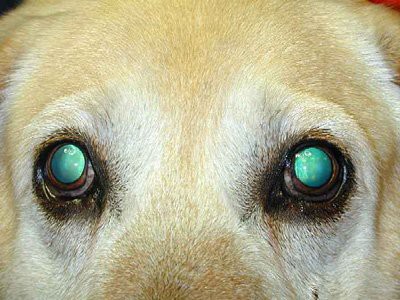
Labrador dogs may suffer from progressive retinal atrophy disease early in its life. The symptoms of PRA include-
- Poor vision in dim light
- Dilated pupils
- Remain indoors during the dark time
- The slow response of pupils to light and a green shine to the eyes
However, it is believed by the vet medical community that a permanent cure is improbable. Specific tests work well to prevent and even ease the severity of this disease.
Hypothyroidism
Labrador dogs may suffer from lymphocytic thyroiditis or idiopathic thyroid gland atrophy.
The symptoms of hypothyroidism include-
- Excessive hair shedding
- Intolerance to cold
- Mysterious weight gain
- Dry coat
- Continual ear
- Skin and toenail infections
The vet may decide on hormone replacement therapy for your affected Labrador dog. Besides, your vet may prescribe Levothyroxine, an oral drug. This drug helps the Labrador to keep normal metabolism in its body.
Retinal dysplasia

Retinal Dysplasia is another significant disease seen in Labrador dogs. It is different for Labrador Dogs of European descent and American descent.
The clear signs of retinal Dysplasia include
- Diminishing vision
- Abrupt complete vision loss or congenital (from birth) blindness.
Retinal Dysplasia comes under the inherited category, and hence complete cure is missing. Retinal Dysplasia is an avoidable disease with careful breeding programs.
The signs of exercise-induced collapse in Labradors include:
- Weakness after 5-15 minutes of strenuous exercise
- Lack of coordination
- Dragging on rear legs
- Dazed, confused appearance
- Collapse
- Staggering, falling to one side, or difficulty maintaining balance is common during recovery
Performing simple exercise instead of hard ones is the right way forward for Labs. Try to reduce the dog’s excitement level. From a vet’s perspective, both phenobarbital and sedative drugs provide some relief.
Cataract
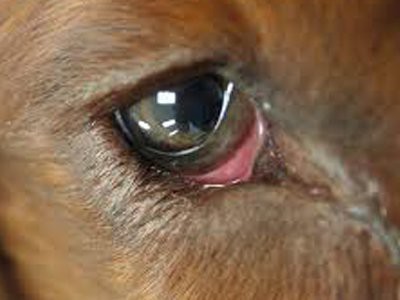
A cataract is a disease that can also affect Labrador dogs. The key symptoms of cataract in a Labrador include-
- Change in its eye color ( an inflamed eye condition)
- Incompetence in doing its usual activity/activities and pain.
The mainly adopted treatment for cataracts is surgery. Nevertheless, the body condition of the Labrador dog to accept such surgery is the critical point for a surgeon to decide.
The dog will get back its normal vision completely, only if the owner follows the vet’s suggestion.
Entropion
Entropion is also a notable disease that affects the eye/s of dogs, including Labrador. The symptoms of this disease include-
- Excessive tearing and watery eyes
- Eye redness
- Eyelid swelling
- Difficulty in opening the eyes during sunlight
- Squinting
- Corneal rupture, depression, and pain
The best treatment usually adopted for Entropion disease is eyelid surgery. The ophthalmologist veterinarian surgeon will remove a small piece of tissue from below the eyelid.
The two sides of the remaining tissue remained placed together and sutured. Vets may use general anesthesia during the procedure.
Tricuspid valve dysplasia
Labrador dogs are also noted to suffer from tricuspid valve dysplasia syndrome. The symptoms include
- Distended stomach due to fluid accumulation (ascites)
- Heart murmur
- Exercise intolerance
- Dyspnea due to lack of oxygen in the bloodstream
- Rapid heartbeat
The treatment for this condition includes digoxin, an angiotensin enzyme inhibitor, and furosemide. Giving diuretics will help with fluid retention. Improving the flow of blood in the heart can be very valuable.
If these drugs do not seem to cure the dog’s ailment, the dog may need surgery. The veterinarian specialist will examine the condition of the dog and then decide.
Hotspots
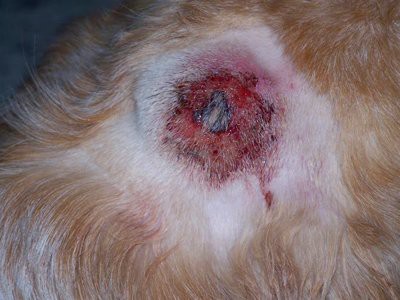
The hotspot is a disease that occurs in a Labrador dog due to bacterial infections. The symptoms notable are skin irritation and inflammation.
The first step while treating the affected dog is to remove the hairs that lay around the dog’s hot spot. Your dog is now ready for cleaning.
The following treatments that are frequently noted to be given for hot spots disease in a Labrador dog are:
- Topical treatment includes the use of creams, ointments, or sprays. This treatment eradicates the bacteria to a great extent. The dog can feel a gradual reduction in its inflammation and pain.
- Vets treat the dog with oral antibiotics for a period ranging from three to four weeks.
- They may administer corticosteroids to help the dog from the pain and itchiness. This occurs because of inflammation.
- Also, they may prescribe antihistamines for the dog to manage the itchiness.
English Labrador Puppy Price
The price of an English Labrador puppy in the UK pet market comes with a medium price tag. It is between £650 to £850. This is an average price for a puppy that is well-bred and keeping good health.
English Lab Breeders in the UK
Lovely Chocolate Labradors
Address: Lutterworth, Leicestershire
Telephone: 07724600386
Llanstinan Home Farm
Address: Letterston Haverfordwest SA62 5XD
T: 01348 840 676
M: 07768 272 745
E-mail: info@llanstinanlabradors.co.uk
English Lab Breeders in The USA
- Delian Labradors
Address: 1689 east county road 300 north
Center Point, Indiana
Tel: 1-812-201-6942
delianlabs@aol.com - Wild Slough British Labradors
Address: Le Center, Minnesota
Tel: 612.327.2898
info@wildslough.com - Excalibur Labradors
Address: 229 Perry Hill Rd. Acushnet, MA 02743
Telephone: 508-951-3179

